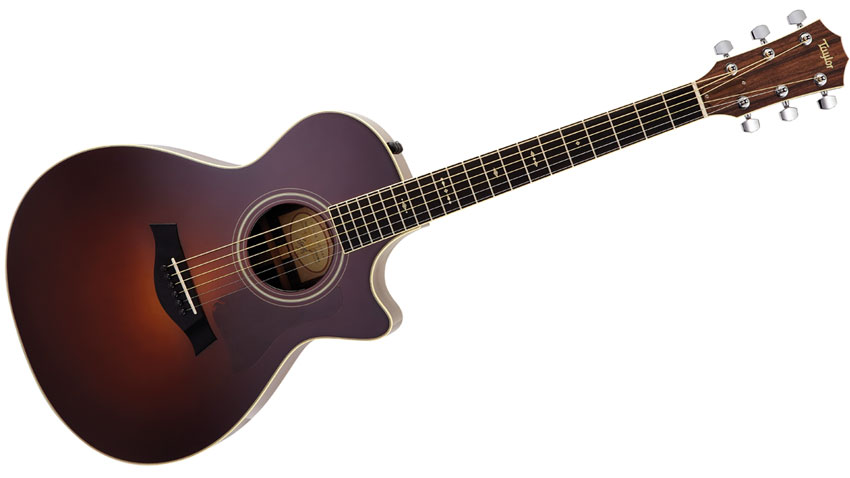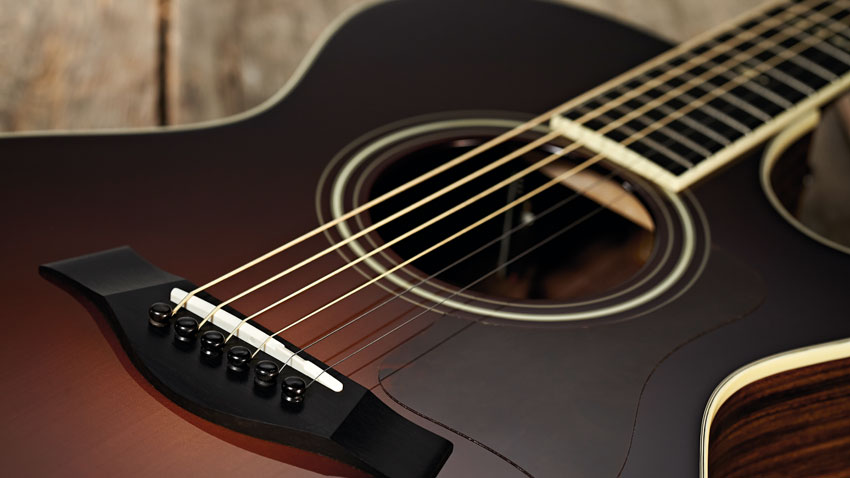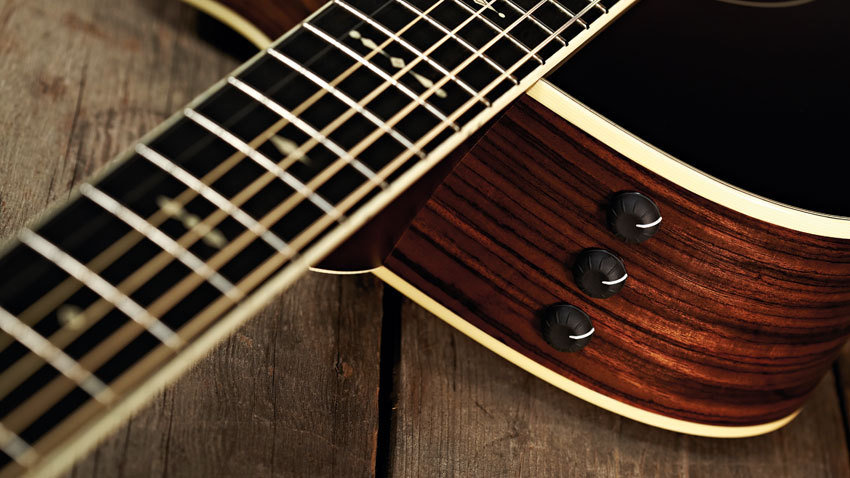MusicRadar Verdict
A superb all-rounder - a guitar that will accompany you from the sofa to the biggest stages effortlessly.
Pros
- +
Build. Vintage styling. Playability. Sound.
Cons
- -
Nothing.
MusicRadar's got your back

Taylor 712ce

Taylor 712ce (soundhole)

Taylor 712ce (preamp)
Taylor, despite building guitars since 1974, is still seen as the very modern opposite to Martin's oh-so-vintage style. That perception will probably never change, but this year's Taylor line features the overhauled 700 Series that, "with their vintage sunburst tops and ivoroid heritage fretboard inlays conjure a distinctively old-school Americana vibe".
The 381mm (15-inch) wide body size puts Taylor's grand concert in the same ballpark as Martin's 000/0M and, for 2012, the 700 series has an Engelmann spruce top with Indian rosewood back and sides - all solid, of course - with tropical mahogany necks, ebony fingerboards and bridges.
"The rich brown finish is perfectly contrasted by grained ivoroid binding around the top and back edge"
It has a very dark brown, gloss-finished top with a brighter orange 'sun' in the centre. A similarly hued 'burst is applied to the neck back while the rosewood is left natural gloss. This rich brown is perfectly contrasted by grained ivoroid binding around the top and back edge, and also along the fingerboard edges.
Cosmetic embellishments are tastefully sparse: black/white purfling inside the top's edge binding, a very thin purfling strip covering the two-piece back's centre joins, three-ring ivoroid/purfling soundhole ring and the same ivoroid inlays at the 5th, 7th, 9th, 12th and 15th fret fingerboard positions.
The guitar has a headstock-end truss rod adjuster and, of course, it uses Taylor's NT bolt-on neck. The fret ends sit over the binding with the standard Taylor radius of 381mm (15 inches).
The steel-string 712ce, in typical Taylor style, uses a bound spade head, and has a 14-fret neck joint with Taylor's shorter scale of 632mm (24.875 inches). Despite being quoted with a rim depth of 111.1mm (4.375 inches) it measures 108.2mm, tapering down to 89mm at the heel. The Venetian cutaway has an upward curve to its tip and the top bracing is Taylor's forward-shifted X-braced pattern with a relief rout around the underside edge and four back braces.
We have a typical Taylor neck with a 44.7mm nut width and 38.5mm string spread with 51mm string spacing at the pin bridge. Depth-wise, the 712ce measures 21.8mm at the first and 22.7mm at the 11th with a slightly more V'd profile than its nylon sibling, especially in the lower neck positions.
Electrics-wise, Taylor's proprietary Expression System (ES) is standard - two transducers, like mini microphones, are attached internally, one to the bass side of the bridge, the other buried within the neck joint. The preamp board is mounted to the bass side of the neck block directly under the three soft-rubber knobbed volume, treble and bass controls. Each has a subtle centre notch, the active EQ providing cut and boost.
Through the 101mm diameter soundhole the circuit board is easily visible and a small slide switch allows you to turn the body sensor on or off. It's shipped with it on (the switch towards the top of the guitar) and a red LED lights up when you plug in.
Sounds
"The word intimate springs to mind - not only in size, but acoustic sound and projection"
The larger-bodied GA (14 series) is Taylor's most popular design but this smaller GC has long been one of our favourites. The word intimate springs to mind - not only in size, but acoustic sound and projection. While many smaller-bodied guitars can really belt it out, that's not really what we have here.
What the 712ce lacks in brute force it more than compensates for in balance between lows, mids and highs. For fingerstyle, you might have to work your thumb a little harder - hybrid pick/finger technique works extremely well and strummed and flat-pick styles are effortless, not only because of that balance, but also thanks to fast, almost electric-like playability. The tonal balance, pristine intonation and slick playability take some beating.
To generalise, the ES sits between the zingier, fast attack of a typical undersaddle system and the darker, more magnetic sound of a quality soundhole pickup. The lower positions sound the most acoustic-like; as you move up the 'board, especially for lead lines, it sounds thicker and also a little less 'acoustic'. This is a real bonus for players perhaps leaning on the bluesier/jazzier side of the tracks, a bane for those so used to a piezo's often brittle higher position tonality.
The onboard controls are well placed for quick adjustments, and also in terms of the EQ's sensible cut and boost. There's no midrange control but boosting both EQs creates a mid-dip, and vice-versa.
The output of the 712ce's ES system isn't excessive - noticeably lower than our Fishman-equipped Martin reference - but we have to say the string-to-string output sounds extremely natural by comparison and the clear, clean high-fidelity sound is extremely rewarding. Turning off the body sensor has a subtle effect tonally, slightly less hi-fi and sparkly; it does, however, usefully limit body noise, which can be problematic at high onstage levels.
The steel-string 712ce is one of those dream all-rounders that feels, sounds and plays superbly. Factor in the very cool visual aesthetic, effortless playability and what is a just-about realistic price for a premium USA guitar of this quality, and you have a hugely attractive instrument.
Dave Burrluck is one of the world’s most experienced guitar journalists, who started writing back in the '80s for International Musician and Recording World, co-founded The Guitar Magazine and has been the Gear Reviews Editor of Guitarist magazine for the past two decades. Along the way, Dave has been the sole author of The PRS Guitar Book and The Player's Guide to Guitar Maintenance as well as contributing to numerous other books on the electric guitar. Dave is an active gigging and recording musician and still finds time to make, repair and mod guitars, not least for Guitarist’s The Mod Squad.
“A synthesizer that is both easy to use and fun to play whilst maintaining a decent degree of programming depth and flexibility”: PWM Mantis review
“I feel like that song had everything we needed to come back with”: Bring Me The Horizon’s Lee Malia on Shadow Moses, its riff and the secrets behind its tone, and why it was the right anthem at the right time
“I said, ‘Are we sure we can write a song about death?’”: The story of Mike + The Mechanics' classic No.1 The Living Years










